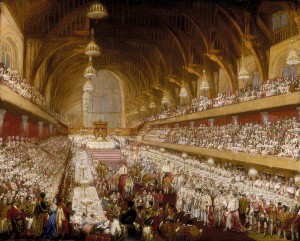Given that the British peerage system developed over time, its labyrinthine rules and unfamiliar nomenclature are not all that surprising. As feudal peerages – a somewhat amorphous class bound by land tenure and military service – gave way to peerages granted by the monarch, the rules governing titles and their inheritance evolved into what we have today.
Several readers of my previous post on the subject were perplexed by courtesy titles. The peerage system in the United Kingdom affords peerage holders and their immediate relatives a variety of titles signifying rank, some hereditary and bound to one holder at a time, others “by courtesy” and held by some or all members of a particular generation.
The Dukes of Devonshire can provide examples. The peerage holder is the present Duke; his wife is the Duchess. The Duke’s mother, who died in September, was the Dowager Duchess, as the widow of the previous holder of the title.
Now things get trickier. The Duke of Devonshire’s forebears amassed a number of hereditary titles. The Duke’s other titles include Marquess of Hartington, Earl of Burlington, and Lord Cavendish. “By courtesy,” his son and heir is called the Marquess of (or Lord) Hartington, as the marquessate is the second highest-ranking of the Duke’s titles. Lord Hartington’s son is the Earl of Burlington, as an earl is junior to a marquess. If Lord Burlington has a son – the great-grandson of the present Duke – that son is Lord Cavendish, as a baron is junior to an earl.
The Duke has the title; those family members with courtesy titles connected to the peerage do not. His heirs for three generations have courtesy titles, but so, too, do the brothers and sisters of the Duke’s son, grandson, and great-grandson. The younger sons and the daughters of a duke or marquess are, by courtesy, termed Lord X or Lady Y Smith. The wife of Lord X Smith is called Lady X Smith, as in the case of Lady Andrew Cavendish.
The younger sons of an earl are The Honourable (Hon.); the earl’s daughters are Ladies. The Hon. as a courtesy title does not correspond to the more familiar usage (to Americans) of The Hon. in front of the name of a member of Congress, an Ambassador, or some other dignitary. In the United Kingdom, social use of The Hon. denotes that that person is
- the younger son of an earl,
- a son or a daughter of a viscount – the peerage level between earl and baron – or a baron, or
- a woman married to the younger son of an earl or any son of a viscount or baron.
The husbands of the daughters of dukes, marquesses, earls, viscounts, and barons do not take any rank from their wives; the wives of the younger sons of dukes and marquesses are styled as above (e.g., Lady Andrew Cavendish); and the wives of the younger sons of earls and the sons of viscounts and barons are The Hon. Mrs. X Smith, as they do take their rank from their husbands.
In effect, courtesy titles signal membership in the clan gathered around the peerage holder as well as the larger British aristocracy. To review, a duke > a marquess > an earl > a viscount > a baron, and the siblings and descendants of the title holder rank in the same way: the son of a duke outranks, and takes precedence of, the son of a baron.
N.B. To further confuse matters in this example, the present Lord Hartington is known professionally as William Burlington; he uses the earldom while his son is known as Lord Cavendish!
Share this:
About Scott C. Steward
Scott C. Steward has been NEHGS’ Editor-in-Chief since 2013. He is the author, co-author, or editor of genealogies of the Ayer, Le Roy, Lowell, Saltonstall, Thorndike, and Winthrop families. His articles have appeared in The New England Historical and Genealogical Register, NEXUS, New England Ancestors, American Ancestors, and The Pennsylvania Genealogical Magazine, and he has written book reviews for the Register, The New York Genealogical and Biographical Record, and the National Genealogical Society Quarterly.View all posts by Scott C. Steward →
